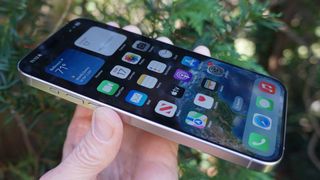The iPhone 16 Pro could solve the only reason I upgraded to the iPhone 15 Pro Max
We’re just a few weeks away from what’s expected to be a bunch of exciting new iPhone 16 smartphones. If the rumors are true, I might just make the switch.
I’m not talking about the switch from Android to iOS. As a smartphone reviewer, I have a habit of carrying multiple phones of all types at once. But only one phone gets my personal number and is my primary device.
For the better part of a year, that’s been an iPhone 15 Pro Max. Lugging around a 6.7-inch phone is a big deal for me, and while I appreciate that massive Super Retina XDR display, I’ve always felt it was too big for my day-to-day use.
Until last year’s iPhone 15 lineup, there wasn’t a compelling reason to choose a Pro Max version over a Pro. They were essentially the same device, aside from screen size (a few more pixels, but not a higher resolution) and a larger battery. The latter was usually a tie, as a larger screen drains the battery faster, so battery life between the Pro and Pro Max models was usually roughly identical.
With the 6.3-inch iPhone 15 Pro and iPhone 15 Pro Max, Apple opted to only include tetraprism technology in its largest and most expensive phone, the iPhone 15 Pro Max. Tetraprism technology is somewhat similar to the periscope tech Samsung used to push 10x optical zoom into the Samsung Galaxy S23 Ultra. However, tetraprism doesn’t use a prism with that much distance from the sensor. Instead, light from the lens is bounced back and forth through the prism, adding virtual distance and increasing the optical zoom before it reaches the sensor. In the case of the iPhone 15 Pro Max, that translates to 5x optical zoom.
Size matters
As an amateur photographer, I believe in optical zoom. Digital zoom is fun and sometimes useful, but for clarity and visual fidelity, optical zoom is the way to go. Combined with a decent 12MP or higher sensor and powerful computer image processing, high-powered optical zoom on a smartphone camera can produce impressive results: photos that, unlike digital and AI-enhanced zoom, can withstand some criticism.
I was spoiled by Samsung’s 10X zoom, despite Samsung pairing it with a somewhat mediocre sensor. Later Ultras reduced the optical zoom power to 5X but increased the sensor size significantly, meaning there’s far more detail and you can pick out distant objects as if you had a longer zoom.
Either way, once you have 10x optical zoom, it’s hard to go back to 3x. So I switched to the iPhone 15 Pro Max. It took a little getting used to the larger, heavier (221g versus the 15 Pro’s 187g) device – it just about fits in most pants pockets – but I’ve grown accustomed to it.

An easier choice
As the iPhone 16 line’s expected launch date of September 10 approaches, I realize I may have to make a new choice.
Recent rumors indicate that Apple Acquires LG Inoteck Tetraprism Lens First used on the iPhone 15 Pro Max and now in both the iPhone 16 Pro Max and iPhone 16 Pro. There’s no indication that Apple will increase the optical distance beyond 5X, but if it combines that with a 48MP sensor with pixel binning (meaning 4 pixels are combined for each in the final photo), it could have enough resolution to act as a 10X optical zoom.
Of course, the addition of a more powerful zoom on the iPhone 16 Pro means it’d have to be feature-wise identical to the iPhone 16 Pro Max, save for the screen size and battery. In that case, the choice might be easy: I switch back to the smaller phone and give my pocket a rest.
But what if the iPhone 16 Pro Max is super thin? … and I love that bigger screen…
